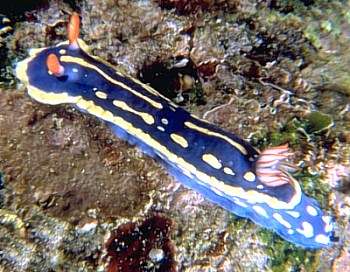
Hypselodoris festiva
(A.Adams, 1861)
Order: NUDIBRANCHIA
Suborder: DORIDINA
Family: Chromodorididae
DISTRIBUTION
. Because of the confusion surrounding the identification of this and similarly coloured species it is difficult to be sure which published records of this species are correctly identified. At present this species is known from Japan and Hong Kong.
PHOTO
Kominato, Boso Peninsula, Japan. PHOTO: Yoshi Hirano.
This blue and yellow species of Hypselodoris is characterized by the uniform blue background colour, a median yellow line (usually unbroken), and a series of yellow spots or streaks forming a line down each side of the mantle behind the rhinophores. There is a thin irregular yellow border to the mantle and the rhinophore club and gills are edged in orange. It grows to 30 mm in length. Another species with the same species name, Mexichromis festiva (Angas, 1864) was reported earlier from Hong Kong (Orr 1981: 26 - as Chromodoris festiva).
Reference:
• Baba, K. (1995). Anatomical and taxonomical review of four blue-patterned species of Hypselodoris (Nudibranchia: Chromodorididae) from Japan. Venus (Japanese Journal of Malacology), 54(1): 1-15.
• Rudman, W.B. & Darvell, B.W. (1990) Opisthobranch molluscs of Hong Kong. Part 1. Goniodorididae, Onchidorididae, Triophidae, Gymnodorididae, Chromodorididae, (Nudibranchia). Asian Marine Biology, 7: 31-79
Rudman, W.B., 1999 (July 1) Hypselodoris festiva (A.Adams, 1861). [In] Sea Slug Forum. Australian Museum, Sydney. Available from http://www.seaslugforum.net/find/hypsfest
Related messages
Hypselodoris festiva from Korea
October 24, 2002
From: Dong Bum,Koh
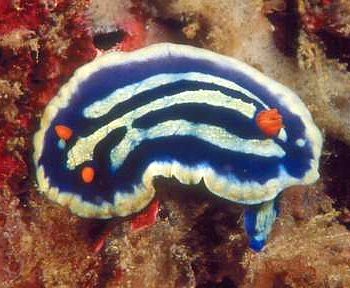
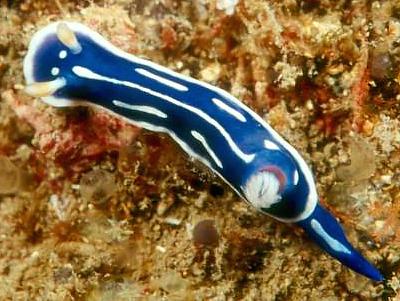
Dear Bill,
Here are two photos which I suspect are both of Hypselodoris festiva. But the shape & color pattern of the lower one is a little different when compared with a typical form [upper photo]. Could you give me ID about this? They are both from:
Moon islet in Che Ju island. Korea.
18m depth. May. 2000.
Photo: Dong Bum,Koh
Best regards,
Dong Bum, Koh
drkoh@seasee.co.kr
Koh, D.B., 2002 (Oct 24) Hypselodoris festiva from Korea. [Message in] Sea Slug Forum. Australian Museum, Sydney. Available from http://www.seaslugforum.net/find/8232Dear Dong Bum,
Baba (1995) discusses two colour forms of H. festiva but they revolve around the presence or absence of dark blue black spots, not the absence of yellow and orange pigmentation, as in your lower photo. However, considering how similar the general colour pattern is. I would think the most reasonable explanation is that the lower individual is an abnormal specimen in which the pigment which produces the orange and yellow markings is almost completely absent. A faint orange tinge on the rhinophores and gills would seem to support this idea. Of course a look at the anatomy might show differences but I suspect you would learn more by checking how abundant this pale colour form is, and whether it is feeding on the same sponge, and perhaps aggregating with more typical colour forms of H. festiva.
• Baba, K. (1995). Anatomical and taxonomical review of four blue-patterned species of Hypselodoris (Nudibranchia: Chromodorididae) from Japan. Venus (Japanese Journal of Malacology), 54(1): 1-15.
Best wishes,
Bill Rudman
Re: Feeding in Hypselodoris festiva
September 7, 2002
From: Jun Imamoto
Dear Ron, Andrej and Bill.
Thank you all for your comments. It has helped me learn about Polychaeta. I appreciate it very much.
Best Regards,
Jun Imamoto
imamoto@wips.co.jp
Imamoto, J., 2002 (Sep 7) Re: Feeding in Hypselodoris festiva. [Message in] Sea Slug Forum. Australian Museum, Sydney. Available from http://www.seaslugforum.net/find/7905Re: Feeding in Hypselodoris festiva
September 6, 2002
From: Jun Imamoto
Dear Andrej and Bill.
Thank you for your comment. I agree that it is a polychaete worm. I observed the 'feeler' expanding and contracting.
Why does this animal do attack? I think the worm is being defensive rather than aggressive. If the sponge is eaten then the worm's place to hide disappears. It is pleasant to observe a sea slug and think about how it lives.
Best Regards,
Jun Imamoto
http://umiushi.zive.net/
imamoto@wips.co.jp
Imamoto, J., 2002 (Sep 6) Re: Feeding in Hypselodoris festiva. [Message in] Sea Slug Forum. Australian Museum, Sydney. Available from http://www.seaslugforum.net/find/7900Thanks Jun,
Bill Rudman
Re: Feeding in Hypselodoris festiva
September 6, 2002
From: Ron Velarde
Dear Andrej, Jun and Bill,
My first impression was that the "structure" shown was the antenna of a decapod crustacean that was living in or near the sponge. However, with the new close ups, Andrej is correct, this is a syllid polychaete, possibly Haplosyllis spongicola. In the new close up (inset), you can see the two triangular anterior palps. And if you look closely at the original photos, you can see a bulbous structure internally, just behind where the worm is making contact with the nudibranch, this is the proventriculus which is characteristic of the family Syllidae. The proventriculus is used to aid in the extension of the pharynx which is usually armed with a tooth or series of teeth (trepan) in the syllids. Thus you captured the moment; "Don't tread on me!" or "Please don't eat me!".
Keep up the good work!
Ron Velarde
rvelarde@sandiego.gov
Velarde, R., 2002 (Sep 6) Re: Feeding in Hypselodoris festiva. [Message in] Sea Slug Forum. Australian Museum, Sydney. Available from http://www.seaslugforum.net/find/7904Thanks Ron,
This looks like it could be an interesting story - although not primarily a nudibranch one. I remember reading a research paper years ago which showed that the commensal anemone fish Amphiprion not only gained personal protection from living in large anemones, but because they were territorial and relatively aggressive to other fish they also gave the anemone protection from predation. It would be an interesting research project for someone to see whether these worms provided similar protection for the sponge - or perhaps someone already has?
Best wishes,
Bill Rudman
Re: Feeding in Hypselodoris festiva
September 5, 2002
From: Andrej Jaklin
Dear Jun and Bill,
From the pictures I would say that this poor guy was attacked (and bitten) by some polychaete worm, living in the prey sponge! This attack can be attributed to feeding or defending behaviour.
Regards,
Andrej
jaklin@cim.irb.hr
Jaklin, A., 2002 (Sep 5) Re: Feeding in Hypselodoris festiva. [Message in] Sea Slug Forum. Australian Museum, Sydney. Available from http://www.seaslugforum.net/find/7896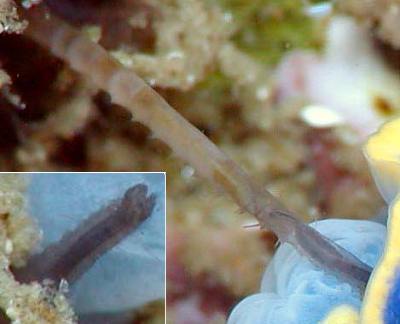
Dear Andrej,
Thanks for the suggestion. I have had another look at the original photos that Jun sent me and I agree that a polychaete worm is a much better suggestion. I have included closeups alongside which show what I presume is part of the polychaete foregut in the fully extended worm. In the inset we can see the annulations [wrinkles] which will disappear as the worm lengthens. I wonder why the worm is so aggressive?
Cheers,
Bill Rudman
Re: Feeding in Hypselodoris festiva
September 4, 2002
From: Jun Imamoto

Dear Bill,
I found this sea slug in a tide pool at the beach. It was feeding on a sponge I think may be Halichondria okadai. While observing this I noticed a strange movement of this sea slug similar to that reported in a recent message by Masayoshi Nishina. Then, I discovered the tentacle which pokes out from under Halichondria okadai, and seems to attack Hypselodoris festiva. I don't think the sponge has such a tentacle. I suspect it belongs to a creature which probably lives with Halichondria okadai.
I am happy if these reports are useful for your research.
Date: 24 Aug 2002
Location: Shimoda, Izu Peninsula, Sagami Bay, Japan
Size: About 20mm
Depth: 0.3m (Intertidal)
Temperature: 26C
Best Regards,
Jun Imamoto
http://umiushi.zive.net/
imamoto@wips.co.jp
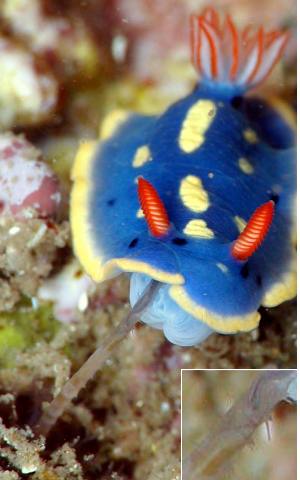
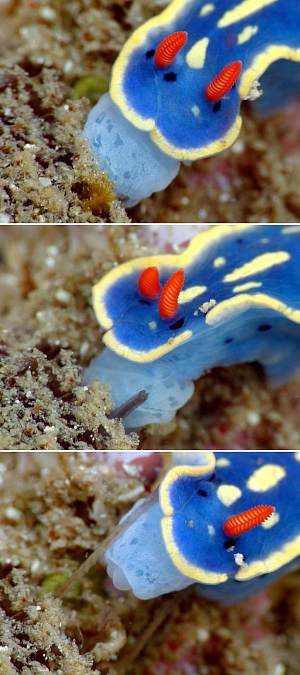
Thanks Jun,
I suspect from the hairs and joints that this 'tentacle' is a leg of a crustacean. It ceratinly isn't making life easy for the Hypselodoris.
Best wishes,
Bill Rudman
Feeding in Hypselodoris festiva
August 10, 2002
From: Nishina Masayoshi
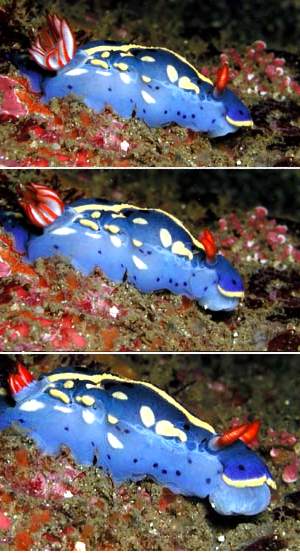
Dear Bill,
Your comment on food of Doto cf. pita is quite understandable. Sometimes it is almost impossible to be sure what they are eating.
Here are a series of photos of a Hypselodoris festiva, my wife and I observed for a while and photographed. But we could not recognise what they were eating. I often see Hypselodoris festiva like this - apparently eating mud. Probably there is some kind of sponge hidden there. The photos on the right show a sequence from the top where some 'food' is sensed and it everts its oral tube. At lower left there is a photo [upper] of an animal with its head apparently 'buried' in the mud and [lower] a photo of the animal showing an intense reaction - it seemed be reacting to a sharp pain while eating.
Date: 29 June 2002
Loc: Enoura, Sagami Bay. Japan
Lengh: 25mm
Depth: 4m
Water temp: 20C degree
Photos: Left: M. Nishina; Right: C. Nishina.
Best Regards,
Nishina Masayoshi
nishina@wips.co.jp

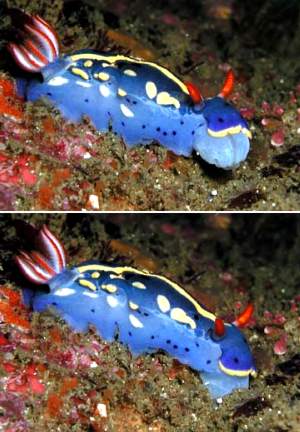
Dear Nishina,
Thanks for this great sequence of photos. It is indeed frustrating when you find a common species apparently feeding very well on nothing identifiable. Here in New South Wales, Hypselodoris bennetti is often found eating the 'mud'. Clearly what they are eating is a sponge which is covered with other marine growths, or is present as a fine network of tissue entangled with other plant and animal growths. The 'pained' response you describe is usually caused, not by the 'taste' of what it is eating but some physical pain caused perhaps by the bite of a crustacean or worm also living in, on or near the sponge colony.
Best wishes,
Bill Rudman
Hypselodoris festiva from Korea.
June 20, 2002
From: Dong Bum Koh
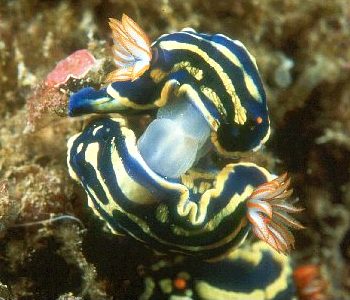
Dear Bill.
This is Hypselodoris festiva from Korea. After more then 10 years experience I got this fine close-up shot of mating. But what is the other one doing in the bottom? Seems to me he want join in this mating ?
date: June 09, 2002.
place: Sup Islet, Cheju Island. S.KOREA
With Best Regards.
Dong Bum, Koh
drkoh@seasee.co.kr
Koh, D.B., 2002 (Jun 20) Hypselodoris festiva from Korea.. [Message in] Sea Slug Forum. Australian Museum, Sydney. Available from http://www.seaslugforum.net/find/7272Dear Dr Koh,
Perhaps they are celebrating South Korea's World Cup victory over Italy? I suspect most times we find nudibranchs aggregating like this it is because they have been attracted to the same food source. I suspect they do not come together to mate, but rather mate when, by accident, they meet, such as when they are together on the same food sponge. So in this case, I suspect all the animals are near, or on, their food sponge, and probably the bottom animal is feeding rather than waiting for its turn at romance.
best wishes,
Bill Rudman
Hypselodoris festiva feeding
March 9, 2002
From: Bernard Picton

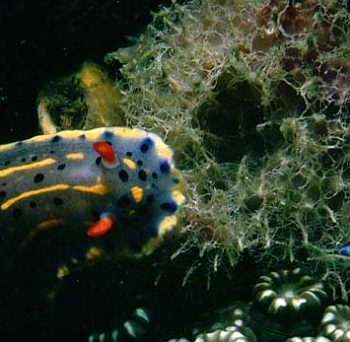
Hi Bill,
I just looked out these pictures of Hypselodoris festiva from Hong Kong, April 1983.
In the second picture you can see an animal which is feeding on what appears to be a keratose sponge. I've noticed that this type of sponge is often eaten by chromodorids, the sponge tissue seems to be taken leaving the spongin skeleton behind.
Bernard
bernard.picton.um@nics.gov.uk
Picton, B., 2002 (Mar 9) Hypselodoris festiva feeding. [Message in] Sea Slug Forum. Australian Museum, Sydney. Available from http://www.seaslugforum.net/find/5956Thanks Bernard,
From my experience most chromodorids feed on keratose or other sponges without a spiculate skeleton. Unfortunately many references in the literature which suggest otherwise seem to be based on poor sponge identifications.
Cheers,
Bill Rudman
Hypselodoris festiva from Hong Kong
January 26, 2002
From: Bill Rudman & Brian Darvell

Here is some information and photos on Hypselodoris festiva from Brian Darvell's Hong Kong collections.
This second blue and yellow species of Hypselodoris is characterized by the uniform blue background colour, a median yellow line (usually unbroken), and a series of yellow spots or streaks forming a line down each side of the mantle behind the rhinophores. There is a thin irregular yellow border to the mantle and the rhinophore club and gills are edged in orange. It grows to 30 mm in length. Another species with the same species name, Mexichromis festiva (Angas, 1864) was reported earlier from Hong Kong (Orr 1981: 26 - as Chromodoris festiva).
PHOTO: Upper, Lower Right: Hong Kong, 1983 (no data). Lower Left: AM C138149, 13 March 1983, Site 4.46, Kong Chau (N), Mirs Bay, 9 m. Photos: Brian Darvell.
Hong Kong Collection Records:
AM C135249, 11 July 1982, Site 8.31, Kong Tau Pai (N of Wang Chau), 5 m. AM C138149, 13 March 1983, Site 4.46, Kong Chau (N), Mirs Bay, 9 m. AM C150259, 2 specimens, 12 April 1986, Site 1. 137, Wong Wan Chau (NW), Double Haven, 7 m. AM C150351, 5 specimens, 4-20 April 1986, Tolo Harbour/Mirs Bay. Depth range: 0-15 m.
Reference:
• Rudman, W.B. & Darvell, B.W. (1990) Opisthobranch molluscs of Hong Kong. Part 1. Goniodorididae, Onchidorididae, Triophidae, Gymnodorididae, Chromodorididae, (Nudibranchia). Asian Marine Biology, 7: 31-79
Best wishes,
Bill Rudman & Brian Darvell


Hypselodoris festiva from Hong Kong
July 6, 2001
From: Leslie Chan
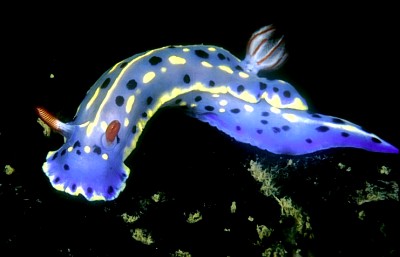
Dear Bill,
Could you identify this nudibranch which I photographed in Hong Kong.
Details: 6m, Hoi Ha Wan, Hong Kong. 16 November 2000.
Thanks
Leslie Chan
leslie@lesmart.com
Chan, L., 2001 (Jul 6) Hypselodoris festiva from Hong Kong. [Message in] Sea Slug Forum. Australian Museum, Sydney. Available from http://www.seaslugforum.net/find/4754Dear Leslie,
This is Hypselodoris festiva. It is one of a group of similarly coloured species found in the Indo-West Pacific, the most widespread species being Hypselodoris infucata
Best wishes,
Bill Rudman
Hypselodoris festiva from Japan
June 24, 1999
From: Yoshi Hirano

Thank you for presenting my series of photos of Flabellina amabilis in the Forum, especially soon after your long travel. They look more beautiful than I expected. Please note that my e-mail address has changed from @earth.s.chiba to @earth2.s.chiba.
Hypselodoris festiva in the attached photo was collected from Kominato, Boso Peninsula, Japan, where I live. We have quite big populations of the species here. I would like to precisely determine what and how many species of sponges are eaten by them, but I am afraid it is not easy because of lack of sponge taxonomists in Japan now.
I think I should seriously learn how to send you photos through internet in order to contribute more for the forum. I am looking forward to see summaries of presentations of the workshop someday if there is chance you get them.
Best wishes,
Yoshi
hiranoyj@earth2.s.chiba-u.ac.jp
Dear Yoshi,
Thanks for the photos of Flabellina and Hypselodoris festiva. I am very happy to publish your photos as they are of value to us all. It is interesting to compare the Hypselodoris with the other 'blue' species from the Indo-West Pacific, such as Hypselodoris infucata.
I am sure we can work out why your photos have been getting 'scrambled' in the internet. Abstracts of all the contributions are being put on the Menfi Workshop website in the next month. Hopefully some of the participants will also send me a summary with photographs, for the Forum.
Best wishes,
Bill Rudman.
